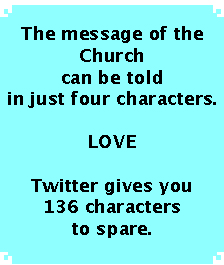Why Twitter for Churches?
Why Twitter, why not Facebook?
 Facebook, the king and queen of social media, has some problems as a platform for churches.
Facebook, the king and queen of social media, has some problems as a platform for churches.
- To be used well, it is a lot of work.
- It is unabashedly about monetization of cyberspace.
- The rules change frequently.
- It can easily become more intimidate than a congregation of unrelated people want to be part of. Facebook rules just changed recently to make posts more public than many users ever intended their Facebook pages to be. We’ll wait with everyone else for the fallout on that.
Facebook has been embraced by business and some nonprofits. They are more likely to have a top-down structure with monetary and hierarchical controls. In other words, Facebook will be part of somebody’s job. It might be their whole job. Few churches can afford that!
Twitter on the other hand comes with some control. You can create a following but you can direct your “tweets.”
The Twitter platform is stripped to the bone. You are limited to 140 characters (practically 120 characters). Who can’t write one sentence a day!?
Let’s look at Twitter. What is it, anyway?
Twitter is a social media platform first designed for people to answer the question, “What are you doing?”
People send simple, short messages. No pictures. No video. No fancy type.
The first reaction from the public, the echoes of which can still be heard, was “I don’t care what you are doing!”
But some people kept reporting their activities to the world anyway.
They soon learned the difference between “This sandwich is delicious.” and “Route 95 is backed up 20 miles. Stay away!”
Slowly with explosive bursts of potential, the world began to realize that there is power in caring about what someone else is doing and how we can influence what happens to them.
Does that not sound mission-oriented?
The power of Twitter is in making connections. Once those connections are made. It is really up to us what we do with them. Twitter is the spark.
There is a good explanation of this power in the book The Tao of Twitter, by Mark Schaefer. There are many good books explaining Twitter. Most of them are written from a marketing point of view. Marketers tend to love numbers and analytics, which if you can bear reading them, are impressive.
(We’ve provided a link to Amazon in our widget column for this inexpensive book.)
Most pastors and church people are not “numbers” people. If they were, they may have already fled the church scene. Church numbers are dismal at first glance and alarming with analysis.
Mark’s book dwells on Twitter’s power, beginning with person to person, one-on-one power. This is something every church needs. It is foundational to mission.
The current and traditional church mission focus is invitational. Build a building, open the doors on Sunday morning, and hope that people are curious enough during those few hours of the week to come to us. We sit in our big churches and wait. For decades we didn’t know how to do mission any other way. The tools to do a better job were out of reach, practically and economically. So we keep doing things the same way, rewarding the congregations that do this the best, despite the nagging realization that even the biggest churches are statistically ineffective.
To use Twitter, requires making an effort to unlearn and change this collective mindset.
How does Twitter differ from Facebook?
 Twitter is beautifully stripped down. You must tell your story in less than 140 characters. Church people can respond to this limitation in one of two ways.
Twitter is beautifully stripped down. You must tell your story in less than 140 characters. Church people can respond to this limitation in one of two ways.
- Protest! We can’t possibly tell our message in 140 characters.
- Cheer! How hard can it be to write one sentence a day!
Twitter will be manageable for any pastor or any lay leader. It is possible to put Twitter to work with as little as 15 or 20 minutes of effort per day. That’s good news!
